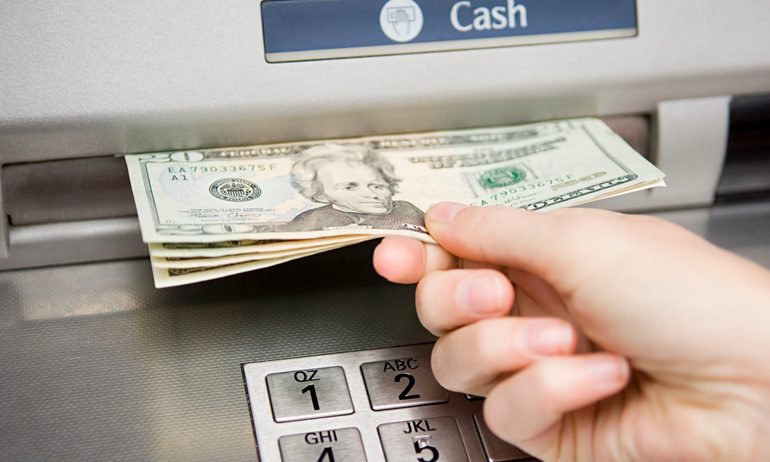How to Cash a Check (And Save on Fees)
Major retailers, or the payer’s bank or credit union, can cash a check for a small fee. But the better option is your own financial institution.

Many, or all, of the products featured on this page are from our advertising partners who compensate us when you take certain actions on our website or click to take an action on their website. However, this does not influence our evaluations. Our opinions are our own. Here is a list of our partners and here's how we make money.
If you get a payment by check, you can cash it or deposit it in several ways. If you have a bank account, you can do so at an ATM, with a teller or through your banking app. Without a bank account, cashing a check is still a fairly simple process through other methods, such as using a retailer.
But the best long-term solution is to get a checking account, either at a brick-and-mortar bank or with a bank that provides strong online checking accounts; cashing a check at your own bank is free and is the most convenient route.
Here’s how to save on fees when cashing checks.
» MORE: Can I cash a check at any bank?
How to deposit or cash a check step by step
Visit a major retailer or use your bank's services. If you don't have a bank account, go to the bank that's listed on the check or to a major retailer like Walmart. If you're a bank customer, visit one of your bank's branches or ATMs, or make use of mobile deposit through your bank’s app, if it’s offered.
Endorse the check. Just before cashing or depositing the check, sign the back with your name on the line with the X.
Hand over the check with ID or a bank card. If you don't belong to a bank, you'll likely need to show a retail clerk or bank teller your identification, such as a state-issued driver's license or other government ID. Then hand over the check and get your cash. If you're a bank customer, you can go to an ATM or bank teller and present your debit card and the check. A teller might also ask for ID. The check will get deposited first to your account and then you can withdraw cash.
» The parts of a check: How to find your bank routing number, account number and other important information
How much does it cost to cash or deposit a check?
Generally, banks let customers deposit or cash checks for free. If you don't have a bank account or need cash without delay, major retailers provide the service for a fee. Read more below on how the cost varies.
Where to cash a check
The bank or credit union that’s on the check: You should be able to cash a check at the financial institution of the person or company that wrote you the check. However, banks and credit unions are not required to cash checks from noncustomers. If they do, they often charge a fee, which can be a flat amount (such as $8) or a percentage of the check amount (such as 1%). Some banks might also require two forms of ID.
» Does the check look suspicious? Here's a guide to spotting a fake check
Major retailers and grocery stores: Many large retail chains provide check-cashing services, generally for less than $10 per check. Walmart, for example, charges a $4 fee to cash checks up to $1,000 and $8 for anything larger. Kmart has an even cheaper service of cashing checks of up to a certain amount for $1 or less.
Retailer that can load cash onto prepaid debit cards: Prepaid debit cards let you deposit your check, add it to the card’s balance and withdraw cash. To do so, deposit the check either by using mobile check deposit through the card's mobile app, if available, or by visiting a major retailer, such as 7-Eleven or Walmart, that's part of a reload network. Then, withdraw cash either at that retailer location or an ATM.
There can be two fees total, one to load the check onto the card and another to get cash. Prepaid cards themselves can cost between $0 and $10, and there’s also usually a monthly service fee of about $5.
Where to avoid cashing a check
Payday lending store: Payday lending stores, which typically charge a percentage of the amount of the check you're cashing, are an expensive option. You’ll be better off going through a bank, prepaid debit card or retail store.
Best way to avoid fees: Get a checking account
Your own bank or credit union is the best option for dealing with checks you receive. You generally deposit the check first and the full amount likely won't be immediately available to withdraw, but you’ll get access to it within one to two business days. This free and convenient service makes getting a checking account worthwhile.
If a financial institution has closed your checking account — for reasons such as unpaid overdrafts, for example — it may be hard to open a new account. That’s because you may have a record with ChexSystems, a company that tracks closed checking and savings accounts.
Some banks and credit unions will let you open a second chance checking account. These accounts may come with monthly fees, which can offset some of the money you save by avoiding the payday lender. But if you keep a second chance account in good standing for about a year, you may be able to upgrade to a free regular checking account, which will save more money in the long run.
» Where to find one: Second chance checking accounts across the U.S.


